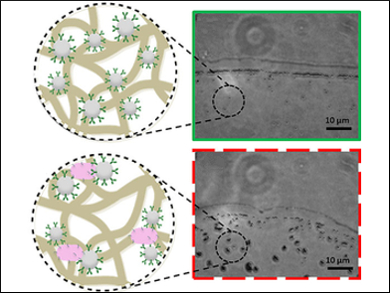Emerging infectious diseases pose a serious public health risk, particularly in rural and resource-limited environments. There, prevention is hindered by the time, materials, instrumentation, or infrastructure required by conventional diagnostics. There is a need for inexpensive, rapid, portable, and versatile pathogen diagnostics to focus limited resources in field and clinical settings.
Jeong-Yeol Yoon, University of Arizona, Tucson, USA, and colleagues have developed a device that is capable of detecting and quantifying bacteria and viruses through the direct use of capillary flow techniques. Antibodies bound to polystyrene submicron particles were loaded onto paper-based microfluidic strips (pictured top). Escherichia coli in water and Zika virus in blood serum samples were loaded to the inlet of the paper channels. Target-antibody binding (pictured bottom) causes changes in the capillary flow rates. Smartphone-captured video clips were used to evaluate the capillary flow rates, which could then be translated into the target concentrations.
Single bacteria and as little as picograms of viruses could be detected directly from blood serum samples with high specificity and very short assay times (30 s). The assay is versatile, handheld, inexpensive, and unaffected by environmental perturbations such as lighting and humidity. These properties make it promising for point-of-care diagnostics in resource-limited settings.
- A Capillary Flow Dynamics-Based Sensing Modality for Direct Environmental Pathogen Monitoring,
Katherine E. Klug, Kelly A. Reynolds, Jeong-Yeol Yoon,
Chem. Eur. J. 2018.
https://doi.org/10.1002/chem.201800085




